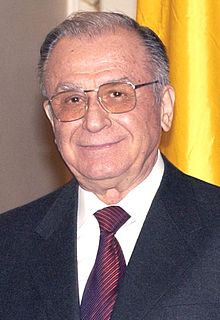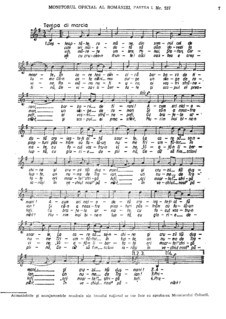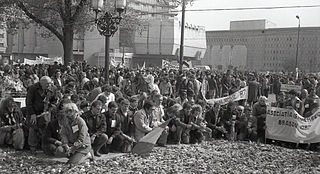 W
WThe Romanian Revolution was a period of violent civil unrest in Romania during December 1989 as a part of the Revolutions of 1989 that occurred in several countries. The Romanian Revolution started in the city of Timișoara and soon spread throughout the country, ultimately culminating in the show trial and execution of longtime Communist Party General Secretary Nicolae Ceaușescu and his wife Elena, and the end of 42 years of Communist rule in Romania. It was also the last removal of a Marxist-Leninist government in a Warsaw Pact country during the events of 1989, and the only one that violently overthrew a country's government and executed its leader.
 W
WThe 1980s austerity policy in Romania was imposed by Romanian dictator Nicolae Ceaușescu in order to pay out the external debt incurred by the state in the 1970s. Beginning in 1981, the austerity led to economic stagnation that continued all throughout the 1980s, a "sui generis shock therapy" which lowered the competitiveness of the Romanian economy and decreased the amount of exports.
 W
WGeneral elections were held in Romania on 20 May 1990 to elect the President and members of Parliament. They were the first elections held after the overthrow of the Communist regime six months earlier and the first free elections held in the country since 1937. It was also the first time the president had been directly elected, the position having been previously elected by the legislature since it was introduced in 1974.
 W
WA constitutional referendum was held in Romania on 8 December, 1991. The new constitution was approved by 79.1% of voters.
 W
WThe Rebellion of Brașov was a revolt against Nicolae Ceaușescu's economic policies in Communist Romania, which erupted on the day of the 1987 local election.
 W
WBrigada Antiteroristă is a tactical special operations unit of the Romanian Intelligence Service.
 W
W"Deșteaptă-te, române!" is the national anthem of Romania.
 W
WDissent in Romania under Nicolae Ceaușescu describes the voicing of disagreements with the government policies of Communist Romania during the totalitarian rule of Nicolae Ceaușescu after the July Theses in 1971. Because of Ceaușescu's extensive secret police and harsh punishments, open dissent was rare. Notable acts of dissent include Paul Goma's 1977 letters to Ceaușescu, the founding of SLOMR in 1979 and a number of work conflicts, such as the Jiu Valley miners' strike of 1977 and the Braşov Rebellion of 1987.
 W
WThis article describes the cabinet of Romania under the first administration of Prime Minister Petre Roman which was formed 26 December 1989 and dissolved 28 June 1990.
 W
WThe Golaniad was a protest in Romania in the University Square, Bucharest. It was initiated by students and professors at the University of Bucharest.
 W
WThe Letter of the Six was an open letter signed in March 1989 by Silviu Brucan, together with five other Romanian Communist Party dignitaries.
 W
WThis is a List of members of the National Salvation Front Council, the governing organization in Romania after the National Salvation Front seized power during the Romanian Revolution, on December 22, 1989. The list was broadcast on national television and first published in Monitorul Oficial, no. 1 on the same day.Marian Baciu Alexandru Bîrlădeanu Ana Blandiana Silviu Brucan Valeriu Bucurescu Ion Caramitru Constantin Cârjan Cristina Ciontu Doina Cornea Dan Deşliu Mircea Dinescu Géza Domokos Captain Emil Dumitrescu Manole Gheorghe General Ştefan Guşe Ion Iliescu Cazimir Ionescu Magdalena Ionescu Eugenia Iorga Mihai Ispas Constantin Ivanovici Captain Mihail Lupoi Corneliu Mănescu Dan Marţian Dumitru Mazilu Marian Mierla Mihai Montanu Aurel-Dragoș Munteanu Vasile Neacşa Paul Negriţiu Sergiu Nicolaescu Petre Roman Adrian Sârbu General Victor-Athanasie Stănculescu Bogdan Teodoriu László Tőkés Ovidiu Vlad Gelu Voican Voiculescu General Dan Voinea
 W
WThe National Salvation Front is the name of a political organization that was the governing body of Romania in the first weeks after the Romanian Revolution in 1989. It subsequently became a political party, and won the 1990 election under the leadership of then-President Ion Iliescu.
 W
WThe Patriotic Guards were Romanian paramilitary formations formed during the Communist era, designed to provide additional defence in case of a foreign attack.
 W
WThe Proclamation of Timișoara was a thirteen-point written document, drafted on March 11, 1990, by the Timișoara participants in Romania's 1989 Revolution, and partly issued in reaction to the first Mineriad. Organized as the Timișoara Society and other bodies of students and workers, the signers expressed liberal-democratic goals, which they saw as representing the revolutionary legacy. The best-known requirement formed the document's 8th Point, calling for all former Romanian Communist Party nomenklatura and Securitate cadres to be banned from holding public office for a period of 10 years, with an emphasis on the office of President. Questioning the status of the governing National Salvation Front, the Proclamation argued that the latter primarily represented a small group of Communist dissidents who had opposed Nicolae Ceauşescu's authoritarian regime and had subsequently monopolized power. These requirements replicated the earlier manifesto authored in Bucharest by philosopher Gabriel Liiceanu.
 W
WRevolution Square is a square in central Bucharest, on Calea Victoriei. Known as Piața Palatului until 1989, it was later renamed after the Romanian Revolution of December 1989. The former Royal Palace, the Athenaeum, the Athénée Palace Hotel, the University of Bucharest Library and the Memorial of Rebirth are located here. The square also houses the building of the former Central Committee of the Romanian Communist Party. In 1990, the building became the seat of the Senate and since 2006 it houses the Ministry of Interior and Administrative Reform.
 W
WThe Romanian Communist Party was a communist party in Romania. Successor to the pro-Bolshevik wing of the Socialist Party of Romania, it gave ideological endorsement to a communist revolution to overthrow the Kingdom of Romania. The PCR was a minor and illegal grouping for much of the interwar period, and submitted to direct Comintern control. During the 1930s, most of its activists were imprisoned or took refuge in the Soviet Union, which led to the creation of separate and competing factions until the 1950s. The Communist Party emerged as a powerful actor on the Romanian political scene in August 1944, when it became involved in the royal coup that toppled the pro-Nazi government of Ion Antonescu. With support from Soviet occupational forces, the PCR was able to force King Michael I into exile, and establish undisguised Communist rule in 1948.
 W
WThe Securitate was the popular term for the Departamentul Securității Statului, the secret police agency of the Socialist Republic of Romania. Previously, before the communist regime, Romanian secret police was called Siguranța Statului. It was founded on 30 August 1948, with help from the Soviet NKVD, while Romania was practically under the Red Army's occupation. Following the overthrow of Nicolae Ceaușescu in 1989, the DSS lived on until 1991, when Parliament approved a law reorganizing the DSS into various subdivisions.